FreeDAO + Freeos
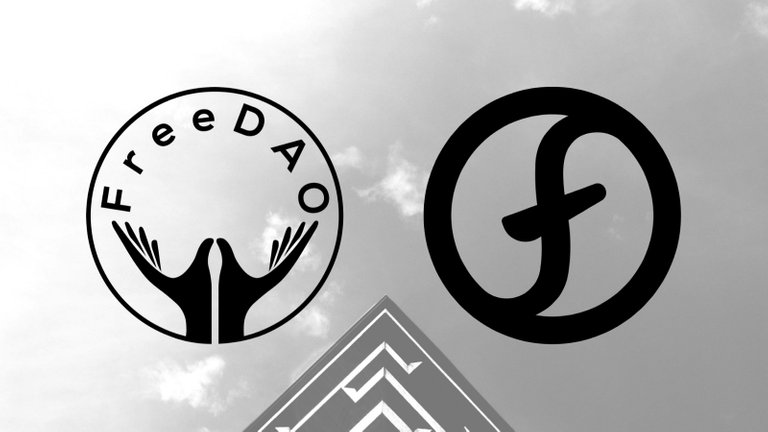
A DAO building a DAO
This article is an overview of the who, what, why and when—related to
FreeDAO and Freeos.
It echoes much of our talk given at a recent BlockchainNZ and Techweek presentation in Auckland, NZ.
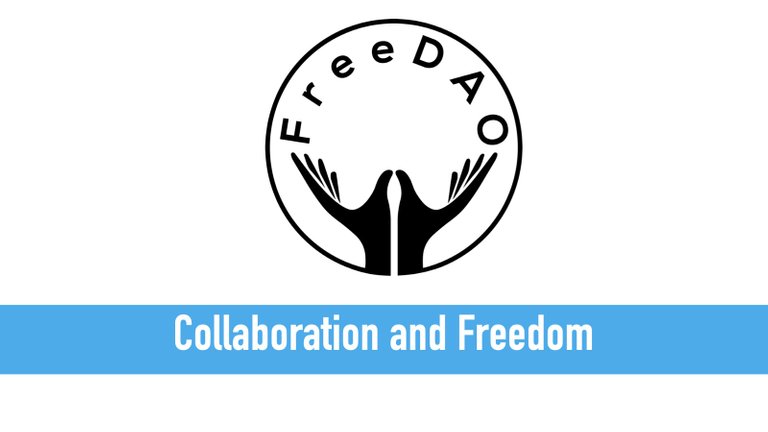
FreeDAO—dedicated to building systems centred around facilitating aspects of collaboration and freedom.
FreeoDAO’s mantra is to create tools of collaboration and freedom— tools that
help incentivise people to cooperate and work together.
These are tools that bring increased freedoms to people’s lives, and it is our firm belief that blockchain can facilitate the creation of systems strongly centred around collaboration and freedom.
We see much of the value of our modern world underpinned by collaboration and freedom. Some of the world’s most valuable companies (Apple, Microsoft, Amazon, Alphabet) happen to be ones where collaboration, teamwork and cooperation is first and foremost.
Interestedly, these collaborative companies often provide high-levels of autonomy and freedom to their employees to attract talent and team players.
Additionally, freedom has great value, reflected by GDP per capita rankings as well as immigration desirability rankings.
It is thought-provoking that a large percentage of countries ranked highly that happen to be also highly ranked on freedom indexes—while the other factor is economics—which we are also covering as described below.

Collaboration and Freedom reflected in the initial people involved and contributing.
FreeDAO has had a great response attracting truly wonderful people who are keen to make a positive impact and believe the projects that FreeDAO is creating can bring about meaningful change.
We have started with a collaborative, autonomous culture of contributors working on systems designed to bring about increased cooperation and freedom in people’s lives.
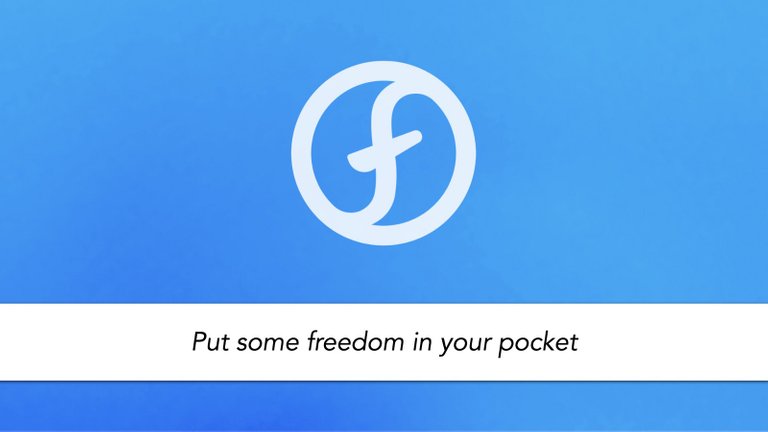
Tackling economic freedom, first.
Our first tool to bring about freedom is aptly named, “Freeos”.
Freeos is designed around economic freedom and helping people have a bit more economic resources at hand.
This is a tricky problem to solve, but we are fortunate to have blockchain, and many recent advances in battle-tested ideas in the realm of decentralised finance (DeFi) at our disposal to give us a good, fighting chance at making good on our vision for Freeos.
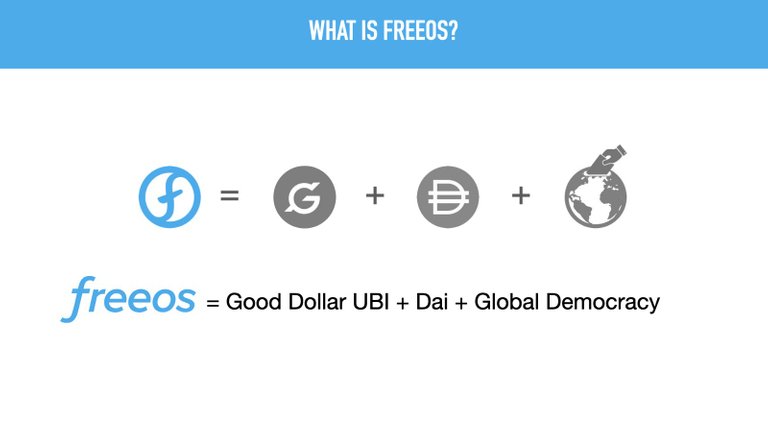
Seems simple when it is put this way.
A simple way to think about Freeos is to combine a crypto-UBI project like GoodDollar with a stablecoin, like Dai.
Instead of using algorithms, Freeos leverages “wisdom-of-the-crowd” to reach price stability, based on consensual purchasing power.
Participants burn FREEOS tokens, for annual access to weekly votes on economic decisions: (inflation, fees, distribution and more) to receive an equal share of the income.
Crypto projects that provide tokens often attract tens, or hundreds of thousands of users quite easily, so we expect Freeos to easily have a similar effect.
Often, token hunters are hedging their bets by grabbing as many free tokens that they can find in the hope that the price of some of their holdings can be of meaningful value.
With the Freeos Economic System, the participants have some influence over the economic conditions to make this possibility much more likely—and we are pulling ideas and technology from blockchain-based Decentralised Finance to give this economy the ability and tools to be meaningful—and valuable.
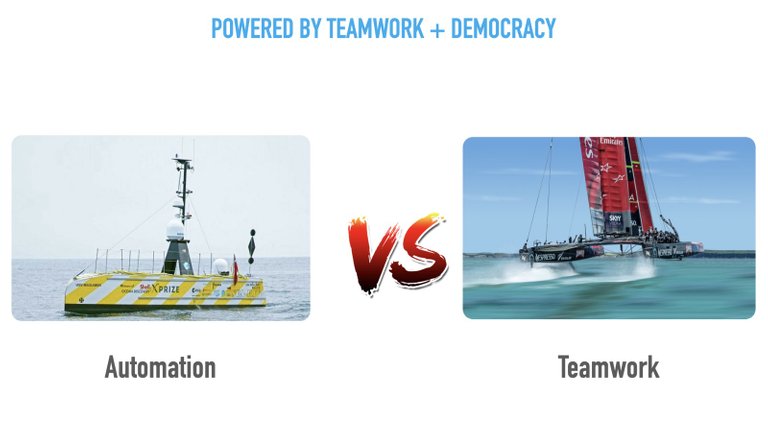
Freeos intends to be another NZ success story, like these 2 vessels
Most stablecoins build a model based on automation and algorithms, while Freeos is building a model based on teamwork and democracy.
The difference between a stablecoin like DAI and Freeos can be compared to an automated sailing drone, like the Uncrewed Surface Vessel (USV) SEA-KIT Maxlimer, versus the New Zealand’s winning Te Rehutai—which won the America’s Cup in 2021.
Both are legitimate ways to sail the choppy ocean effectively—but only the Te Rehutai is based on real-time decisions and teamwork from an active crew.
And using real-time decision-making and teamwork to sail choppy waves is analogous to the model Freeos is using to chart choppy economic peaks and troughs.

Constantly head-to-head in the media—but why not both? Or beyond..?
We are going beyond the classic (left vs. right) debate of “pulling one up by your own bootstraps” vs. “giving handouts”.
Instead, we build a cooperative system so that when each user pulls up their own bootstraps, they lift up others as well.
Effectively, Freeos is not a “handout” but a “hand-in-hand out”.

Big shout out to Proton, Flipmind and Emphasise for their support.
Our Freeos decentralised application (dApp) is meant to have a simple user interface—despite the complexity under the hood that is needed to create a stable, democratic economic system on the blockchain.
We chose Proton—an EOSIO-based blockchain—due to the characteristics that EOSIO blockchains bring, such as:
- Speed (~4000 transactions per second)
- No fees (who wants to pay for every little step, and especially large gas fees?)
- Good tech infrastructure (significant, constant upgrades, good developer
community) - User account system (simple and easy to understand/use)
- Permission system
- Environmental (no crazy mining farms powered by coal)
- Democratic protocol in alignment with our democratic bent
Of all of the EOSIO-based chains we chose Proton due to the extra features and
vision, such as:
- KYC built in (important for a crypto-UBI and democracy)
- Compliance-friendly
- Free accounts
- Amazing wallet and user experience to interact easily with dApps, such as Freeos
- Amazing team that delivers and exceeds expectations
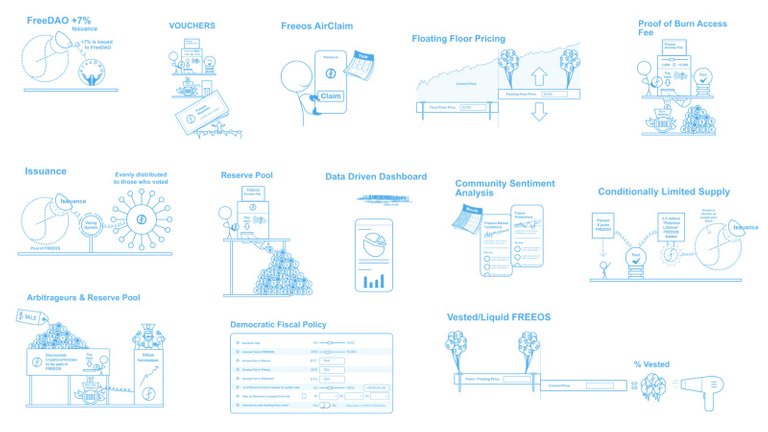
Just some of the many features of Freeos
The Freeos Economic System represents 3 years of system design thinking, and 1 year of dedicated development.
It is not just a simple cryptocurrency, but the beginnings of a new type of economic system.
Cryptocurrencies have a chicken-egg problem and a volatility problem creating friction for mass adoption.
To be adopted widely, a cryptocurrency needs to be in the hands of users—but typically most cryptocurrencies need to be purchased. This is significant friction.
Additionally, cryptocurrencies need some level of stability. Some of the cryptocurrencies that are given freely, like some UBI projects, are subject to volatility. People might stay engaged when the price is good, or promising, but if the price is consistently poor, they can abandon the project. If people and businesses want to utilise a cryptocurrency for day-to-day usage that they can rely on, it needs to be relatively stable.
So, to allow for wide distribution and meaningful price stability, the Freeos Economic System has many features designed to help achieve its vision.
Each of these features could (and is likely to) have an entire article dedicated to it. But for a good overview there is this
article series.
Or the whitepaper.
Or, if you prefer watching a 27 minute video
One aspect that has us very excited, is knowing how well communities of users can influence the economy just through chat rooms, buying, selling and leverage trading. Look at DOGE and Gamestop stocks as recent examples of how a dedicated group of cooperative traders can make a large-scale splash for their own economic interest.
Imagine if such a group had a more sophisticated tool to help manage their own economic destiny. What might they be capable of accomplishing?
Freeos provides these sophisticated tools, in addition to the basic trading tools, to create a greater possibility of economic success.
Now to dig into some of the business model and rollout plan of Freeos.
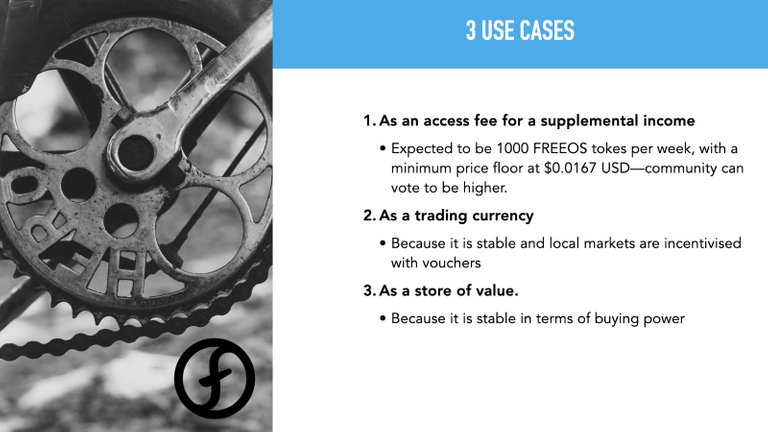
The 3 use cases underpin the value of a FREEOS token
A cryptocurrency needs a reason for its own existence, and it is even better when there are additional levels of usage and economic forces.
There are three main use cases, that give the FREEOS tokens value:
- FREEOS tokens used as an Access Fee,
- FREEOS tokens used as a Trading Currency,
- and FREEOS tokens used as a Store of Value
- Access Fee — participants burn approximately $50 worth of Freeos to gain access for a year. The FREEOS burned will be returned in 3 weeks to 3 months, leaving the remainder of the weekly rewards going in the participants’ pockets.
- Trading Currency — The Freeos Economic System generates NFT “vouchers” when FREEOS tokens are burned for the Access Fee. These vouchers are used to bypass the Access Fee, and are distributed to FreeDAO to help onboard people in target communities. Once a threshold of Freeos participants are concentrated in a community, we will encourage local businesses to accept Freeos for goods. One-by-one this will build a network of Freeos economies around the world.
- Store of Value— In a volatile market like crypto, investors seek a store
of value, between trades. FREEOS tokens are a good fit for this, especially as the price of FREEOS is designed to be stable—in terms of real-world purchasing power. Instead of overinflated fiat-pegged stablecoins, this mechanism could be very attractive to investors and traders wanting to park their assets in something more reliable. And since it will take a bit of time for the currency to rise to a stable value, there is some early room for growth towards stability as well.
With these 3 use cases we expect to attract wide interest in the FREEOS currency.
We’ve already had unsolicited enquiries from crypto investors wanting to buy FREEOS when available. As we are not pre-minting tokens, fulfilling this request will need to occur after the launch.
We expect strong interest to come from these 3 groups:
- AirDrop and Freeos enthusiasts wanting to get in early
- Crypto-savvy investors wanting to store value and invest in the early rise towards stability.
- Crypto-novices, attracted by the ease-of-use, free accounts, zero fees of Proton, wanting to earn cryptocurrencies for the first time.

Where we’re going, we won’t need roads…
We are now in a position to say that Phase 1— the AirClaim—is feature complete and due to launch in Q3, this year.
Phase 1 is where the economy is kick-started, and some of the systems of Freeos play out.
We’re on target for Phase 2—the Governance dApp—to launch Q2, 2022.
Phase 2 is where the fun, and democratic systems, really begin.
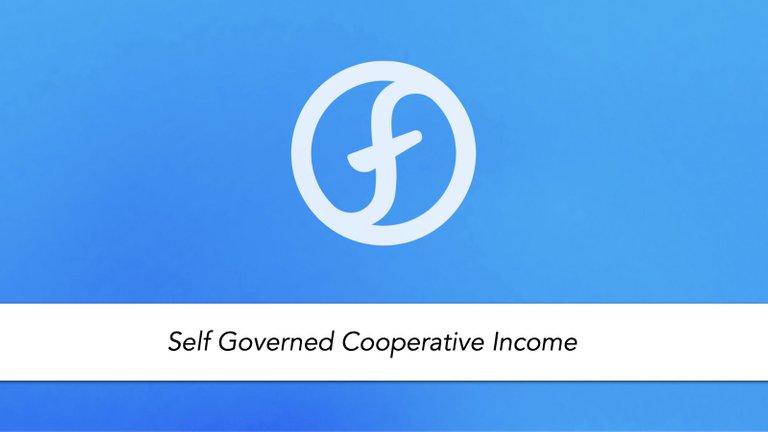
A new type of system deserves a new label.
Freeos is unique enough that other terms don’t quite do the idea justice. We are similar to a UBI on the blockchain, but we have some differences as well. The fact that Freeos is not a government-style, unconditional hand-out is one key difference. Freeos requires participation in the process to receive the income.
Freeos is a Self-Governed Cooperative Income.
Freeos is similar to a crypto UBI, with an emphasis that it is run by the people for the people—and requires participation and a little bit of skin in the game—enabling a meaningful supplementary income.
We expect—using the fixed price floor concept in the diagram and video above—for participants to receive around 52,000 worth of FREEOS tokens per year.
With a price floor of $0.0167 USD (that can be voted towards a higher value by the community) this could—at the very least—supplement an individual’s income.
That could be a very meaningful income, say for a solo mother in developing nations.
In the developed world, it might simply buy some coffees, or maybe pay a power bill. Regardless, it could still have some use and enough of an incentive to participate. Who doesn’t like free stuff?
Once we concentrate participants, by using vouchers to bypass the tiny friction of the Access Fee— a good case can be made to businesses that adopting FREEOS tokens as a payment (even just for occasional special events) could attract people to their business.
We expect real-world activity to help raise the value and perception of the FREEOS token.
At the very least, accepting FREEOS tokens can be a great marketing tool. And just this one use case can start the Freeos economic engine moving.
Imagine this grows to a network of locations around the country/world/region—perhaps people will want to travel to places where they know they can use their FREEOS tokens.
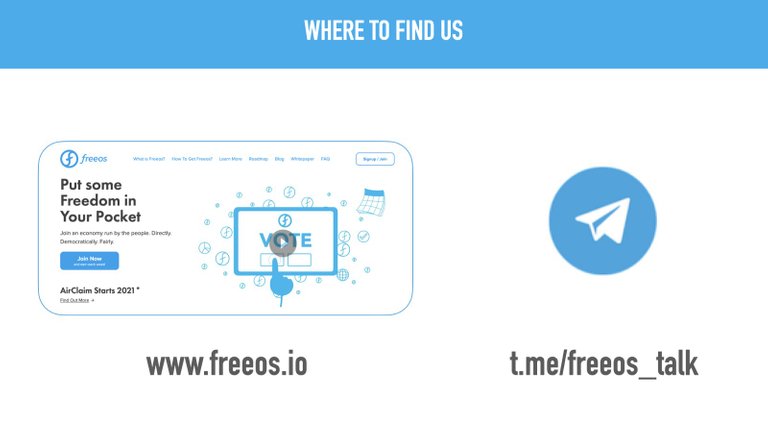
We’re always looking for great people. Please reach out if you feel inclined to:
- Join the team
- Engage in research centred on this idea
- Partner with us
- Connect us with others you think are suitable
- Support us
- Create illustrations/3D models for our promotional
NFTs - Participate in Freeos
- Invest with us (we have received investments, grants, loans and contributions of
around 700K USD, but are looking for development, marketing and expansion
capital)
There’s a non-zero chance that you are the great people—or can put us in touch with those—that we need. And it might be more of a chance than you might think.
So, again, please reach out to us.
You may have contacts, information and ideas that can help us move forward.
We’d love to talk with you.
And—please share this article far & wide.
For more on Freeos, please check our webpage for more info, or join us in our Telegram Community where you may ask more questions about how Freeos is intended to work.
Congratulations @jkelsey! You have completed the following achievement on the Hive blockchain and have been rewarded with new badge(s) :
Your next target is to reach 50 replies.
You can view your badges on your board and compare yourself to others in the Ranking
If you no longer want to receive notifications, reply to this comment with the word
STOPSupport the HiveBuzz project. Vote for our proposal!